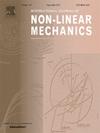研究橡胶弹性的伪可压缩双4链聚合物网络模型
IF 2.8
3区 工程技术
Q2 MECHANICS
International Journal of Non-Linear Mechanics
Pub Date : 2025-04-14
DOI:10.1016/j.ijnonlinmec.2025.105122
引用次数: 0
摘要
橡胶弹性一直是高分子物理学长期研究的课题。目前,橡胶聚合物的发展日新月异,其网络结构异常复杂。为了全面理解这些橡胶材料所表现出的力学行为,进一步发展橡胶弹性的理论框架势在必行。为了理解这一问题,本研究引入了一种伪可压缩双四链模型来分析聚合物网络和橡胶弹性。为了解决四链模型缺乏周期性的问题,构造了考虑固有矩和体积效应的伪可压缩双四链模型。该模型假设了聚合物的各向同性和交联点的仿射运动,改变了坐标系,简化了4链模型。由于4链模型的对称性较差,链变形引起的力平衡与传统朗之万统计模型不同。在幻影网络模型的基础上,利用现象学和尺度方程对体积效应进行了初步估计。根据各种力学试验文献的实验数据验证了所提出的模型,包括压缩性、单轴拉伸、单轴压缩、纯剪切、等双轴拉伸和双轴应变试验。利用文献中的单轴拉伸数据,采用不同模型(所提出的双4链模型、p链模型、Yeoh模型、Anssari-Benam模型)的拟合结果来说明所提出模型的特点。提出的本构模型为研究橡胶弹性提供了一种新的双4链策略。本文章由计算机程序翻译,如有差异,请以英文原文为准。
A pseudo-compressible dual 4-chain model of polymer networks for exploring rubber elasticity
Rubber elasticity has been a subject of studies for an extended period of polymer physics. Currently, the advancement of rubbery polymers is proceeding at an accelerated pace, and the network structure is exceptionally complex. To comprehensively comprehend the mechanical behavior exhibited by these rubbery materials, it is imperative to further evolve the theoretical framework of rubber elasticity. To understanding this problem, this study introduces a pseudo-compressible dual four-chain model for analyzing polymer networks and rubber elasticity. To address the lack of periodicity in the 4-chain model, a pseudo-compressible dual four-chain model is constructed, which accounts for intrinsic moments and volume effects. The model assumes isotropic of the polymer and affine motion of crosslinking points, which changed the coordinate system, leading to a simplified 4-chain model. Due to the poor symmetry of the 4-chain model, the force balance caused by chain deformation is different from that of traditional Langevin statistics models. Based on the phantom network model, preliminary estimates of volume effects were made using phenomenology and scaling equations. The proposed model is validated against experimental data from literature on various mechanical tests, including compressibility, uniaxial tension, uniaxial compression, pure shear, equi-biaxial tension, and biaxial strain tests. Using uniaxial tensile data from literature, the fitting results of different models (proposed dual 4-chain model, p-chain model, Yeoh model, Anssari-Benam model) are also used to illustrate the characteristics of the proposed model. The proposed constitutive model provides a new dual 4-chain strategy for exploring rubber elasticity.
求助全文
通过发布文献求助,成功后即可免费获取论文全文。
去求助
来源期刊
CiteScore
5.50
自引率
9.40%
发文量
192
审稿时长
67 days
期刊介绍:
The International Journal of Non-Linear Mechanics provides a specific medium for dissemination of high-quality research results in the various areas of theoretical, applied, and experimental mechanics of solids, fluids, structures, and systems where the phenomena are inherently non-linear.
The journal brings together original results in non-linear problems in elasticity, plasticity, dynamics, vibrations, wave-propagation, rheology, fluid-structure interaction systems, stability, biomechanics, micro- and nano-structures, materials, metamaterials, and in other diverse areas.
Papers may be analytical, computational or experimental in nature. Treatments of non-linear differential equations wherein solutions and properties of solutions are emphasized but physical aspects are not adequately relevant, will not be considered for possible publication. Both deterministic and stochastic approaches are fostered. Contributions pertaining to both established and emerging fields are encouraged.

 求助内容:
求助内容: 应助结果提醒方式:
应助结果提醒方式:


